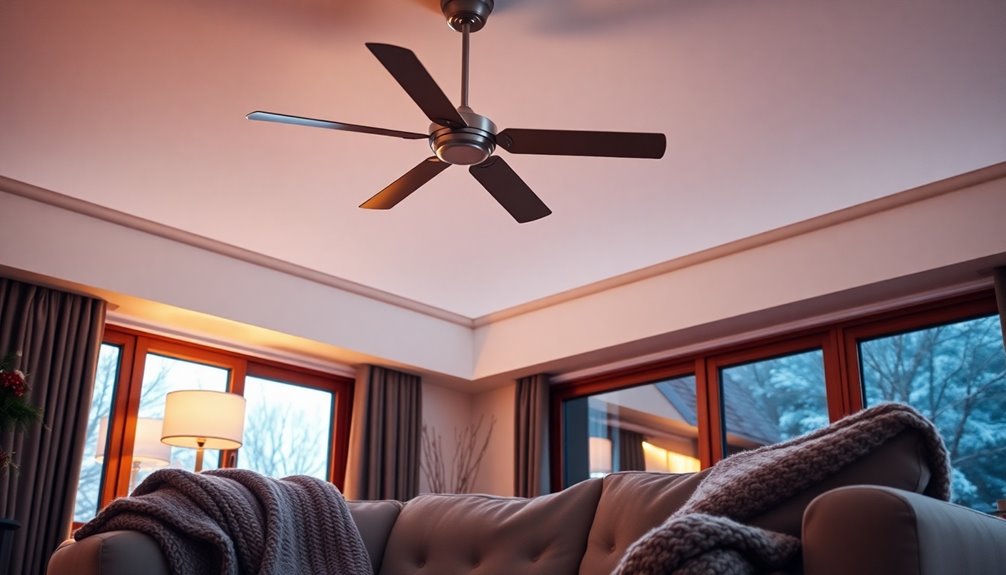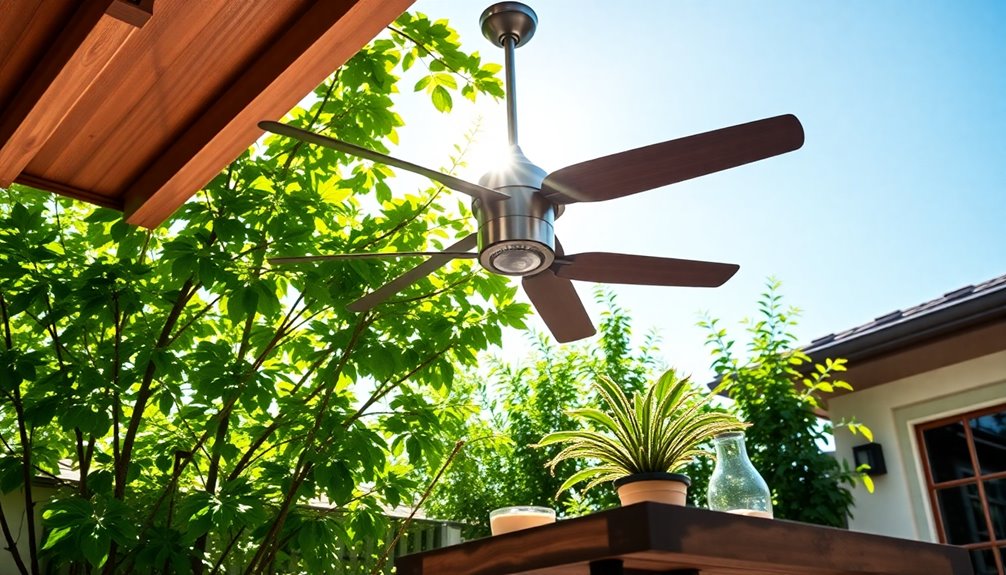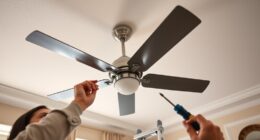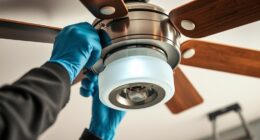Yes, ceiling fans can definitely help in winter. By running your fan in a clockwise direction on low speed, you create an updraft that pushes warm air down from the ceiling. This circulation balances room temperatures and can even cut your heating bills by up to 15%. You'll eliminate cold spots and keep your space comfortable without cranking the thermostat. Just make sure your fan is set to winter mode to maximize efficiency. Want to learn more about getting the most out of your ceiling fan during colder months? There's definitely more to uncover!
Key Takeaways
- Ceiling fans create an updraft that redistributes warm air, enhancing comfort during winter months.
- Running fans clockwise on low speed helps circulate warm air without creating a chilly breeze.
- Proper fan use can reduce heating costs by up to 15% by balancing room temperatures.
- Fans minimize condensation, reducing the risk of mold and mildew in winter.
- ENERGY STAR-rated ceiling fans can significantly lower energy consumption, leading to long-term savings.
Benefits of Ceiling Fans in Winter

When winter rolls around, many people overlook the potential benefits of ceiling fans, but they can actually play an essential role in enhancing your comfort. By setting your ceiling fans to spin in a clockwise direction, you create an updraft that pushes warmer air down from the ceiling. This simple adjustment helps balance the temperature in your room, preventing cold spots and making your space feel cozier.
Using ceiling fans during winter can lead to impressive energy savings, potentially reducing your heating costs by up to 15%. With the improved air movement, you can lower your thermostat settings without sacrificing warmth, which eases the workload on your heating system and can extend its lifespan.
Additionally, the gentle airflow from ceiling fans helps reduce condensation, minimizing the risk of mold and mildew—an important consideration during damp winter months.
Incorporating ceiling fans into your winter routine not only enhances your overall comfort but also promotes a healthier indoor environment. So, as the temperature drops, don't forget to turn on those ceiling fans; they're a smart, energy-efficient tool to keep you warm and comfortable all season long.
Correct Direction for Winter Use

Understanding the correct direction for your ceiling fan is key to maximizing its benefits during winter. To make the most of your ceiling fans, you should guarantee they operate in winter mode with a clockwise rotation. This adjustment helps push warm air down from the ceiling, creating an updraft that enhances overall comfort while reducing heating costs.
Here are three essential tips to remember:
- Change the direction: Switch your ceiling fan to spin clockwise. This movement will draw cooler air upwards, allowing warm air to circulate downwards effectively.
- Set to low speed: Keeping your fan on a low setting prevents a chilly breeze, guaranteeing the warm air remains evenly distributed throughout the room.
- Monitor heating costs: By optimizing your fan direction, you can reduce heating costs by up to 15%. This allows you to set your thermostat lower, maintaining comfort without excessive energy use.
How to Adjust Fan Direction

Adjusting the direction of your ceiling fan is a simple process that can greatly enhance your comfort during winter. Most ceiling fans come equipped with a switch on the motor housing, allowing you to easily change the fan's direction between clockwise and counterclockwise rotation.
For winter use, set your fan to rotate clockwise. This creates an updraft that pushes warmer air down from the ceiling into your living space.
To maximize the heating effect, operate the fan at a low speed while in clockwise mode. This gentle movement helps circulate the warmer air without creating a chilling breeze.
If you have an older ceiling fan model, you may need to refer to the operating manual, as adjusting the direction might require removing the blades.
Once you've made the change, test the fan on low speed to determine if the new direction is ideal for air circulation and comfort in the room.
You'll notice a difference in how the air feels, making your winter months cozier. With just a simple switch, you can enjoy a more comfortable atmosphere while saving on heating costs.
Energy Savings and Efficiency

Ceiling fans can considerably boost your energy savings during winter months. By using a winter-mode fan, you can effectively move warm air that naturally rises to the ceiling, allowing you to feel warmer without cranking up your heating system. This not only enhances comfort but also helps you save money on heating costs.
Here are three key benefits of using ceiling fans in winter:
- Reduced Heating Costs: You can save up to 15% on heating costs by redistributing warm air, enabling you to lower your thermostat settings and reduce energy consumption.
- Cost-Effective Operation: Running a ceiling fan in winter mode typically costs just a few cents per hour, making it a far more economical option compared to traditional heating and air conditioning systems.
- Long-Term Savings: ENERGY STAR-rated ceiling fans can reduce energy consumption by up to 60%, contributing to significant long-term savings on heating bills.
Common Misconceptions About Ceiling Fans

While ceiling fans can greatly enhance energy savings and efficiency in winter, several misconceptions persist about their use. Many believe that ceiling fans are ineffective in winter, but when set to run clockwise, they help redistribute warm air heat trapped near the ceiling, making your space cozier.
Here's a quick look at some common misconceptions:
| Misconception | Truth |
|---|---|
| Ceiling fans cool a room in winter | They mainly circulate warm air. |
| Fans should run continuously | They're best when used only when present. |
| All ceiling fans are the same | Size and blade design matter for effectiveness. |
Another myth is that running fans will save energy considerably; while they can help, the actual savings depend on insulation and your heating system. You might also think that air blowing from the fan creates a wind-chill effect in winter, but that's not the case. Instead, using ceiling fans properly can help you move air and protect your home from excessive heating costs. Understanding these points can help you maximize your heating and cooling efficiency. Additionally, using ceiling fans as part of your energy-efficient technology strategy can further enhance your home's overall comfort and reduce heating costs.
Frequently Asked Questions
Is There Any Point in Using a Ceiling Fan in Winter?
You might wonder if there's any point in using a ceiling fan during winter.
Absolutely! By setting your fan to rotate clockwise at a low speed, you can push warm air that gathers near the ceiling down into your living space.
This simple adjustment enhances comfort and can allow you to lower your thermostat by a few degrees, saving on heating costs.
Plus, it helps maintain an even temperature throughout your home.
Can a Ceiling Fan Make a Room Warmer?
Yes, a ceiling fan can make a room warmer. When you reverse the blade direction to clockwise, it pushes warm air down from the ceiling, creating a cozy atmosphere.
Will a Ceiling Fan Help Circulate Heat?
Think of your ceiling fan as a gentle breeze in a warm room, stirring up comfort.
Yes, a ceiling fan can help circulate heat efficiently. When you reverse the blade direction to clockwise, it creates an updraft that pushes warm air down, making your space cozier.
Running it on a low speed helps distribute heat evenly, reducing cold spots and making your room feel warmer without cranking up the thermostat.
Does Reversing a Ceiling Fan Really Work?
Yes, reversing a ceiling fan really works! When you switch the fan to a clockwise direction, it pushes warm air down from the ceiling, creating a comfortable atmosphere in your room.
You'll notice a significant difference as the warm air circulates better, enhancing your comfort.
Just remember to run it on a low speed to avoid any cold drafts. It's a simple adjustment that can make a big impact on your comfort level!
Conclusion
So, you thought ceiling fans were just for summer, right? Ironically, they can be your secret weapon against winter chills. By simply switching the direction, you're not just stirring the air; you're creating a cozy warmth that wraps around you like a favorite blanket. Who knew that those blades whirling above could help save you money on heating bills while making you feel all snug and toasty? Embrace the unexpected; your fan is a winter ally!









